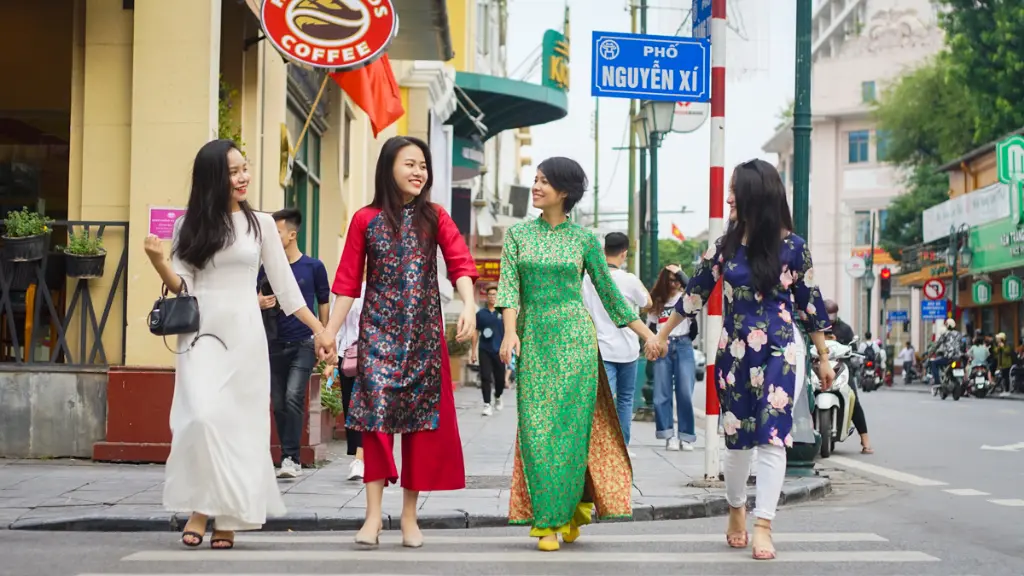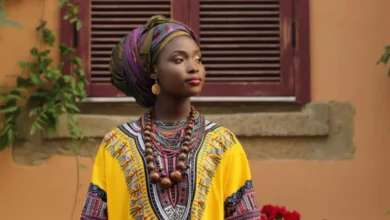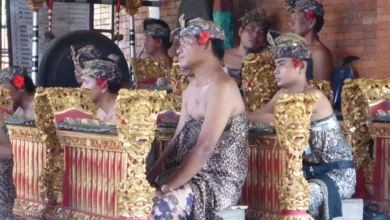The Ao Dai, a traditional Vietnamese garment, is far more than just clothing; it’s a symbol of national identity, a testament to cultural heritage, and a stunning example of artistic expression. This flowing, elegant tunic is instantly recognizable, its graceful lines and vibrant colors captivating the world.
This article delves into the history, evolution, and enduring significance of the Ao Dai, exploring its various styles, the craftsmanship involved, and its place in modern Vietnamese society.
A Glimpse into History: The Origins of the Ao Dai
Pinpointing the precise origins of the Ao Dai is challenging, as its evolution spans centuries. Early forms of the garment, influenced by Chinese and Cham styles, existed in Vietnam as far back as the 18th century. These were loose, long tunics often worn by both men and women. However, the Ao Dai we recognize today, with its close-fitting bodice and flowing panels, emerged during the early 20th century.
The French colonial period played a significant role in shaping the Ao Dai’s evolution. Exposure to Western fashion influences led to the adoption of more form-fitting silhouettes. The four-panel design, which remains a hallmark of the Ao Dai, started gaining popularity around this time. The incorporation of Western tailoring techniques resulted in a more structured and sophisticated garment.
See also Austrian Dirndl and Lederhosen: A Deep Dive into Austria’s Traditional Attire
Austrian Dirndl and Lederhosen: A Deep Dive into Austria’s Traditional AttireDuring the early to mid-20th century, prominent designers began experimenting with the Ao Dai’s design, adding unique embellishments and variations to cater to changing tastes. This was a period of significant stylistic experimentation, leading to the diverse range of Ao Dai styles we see today.
The Four-Panel Ao Dai: A Classic Design

The most common and iconic form of the Ao Dai features four panels: two for the front, and two for the back. This design allows for a graceful, flowing silhouette that accentuates the wearer’s figure. The length typically falls to the ankles, though variations exist. The panels are often split to reveal the trousers worn underneath, adding a touch of elegance and modernity to the traditional garment.
The fabric used for the Ao Dai varies widely, from luxurious silks and satins to lighter cottons and linens. The choice of fabric influences the overall drape and feel of the garment. Silk Ao Dai are particularly prized for their luxurious feel and beautiful sheen.
Embellishments and Details
The beauty of the Ao Dai lies not only in its silhouette but also in its intricate details. Embroidery, beadwork, and other decorative elements are often incorporated, adding layers of artistry to the garment. These embellishments can reflect regional variations, family traditions, or personal preferences.
See also Bairam Costumes in Turkmenistan: A Colorful Celebration
Bairam Costumes in Turkmenistan: A Colorful CelebrationThe collar is another significant design element. Often a high, mandarin-style collar, it adds a touch of sophistication and formality. The collar can be plain or decorated with embroidery or other embellishments, enhancing the overall aesthetic.
Regional Variations: A Tapestry of Styles
While the four-panel Ao Dai is widely recognized, regional variations exist across Vietnam, reflecting the diverse cultural landscapes of the country. These differences can be seen in the colors, fabrics, and embellishments used.
- Northern Ao Dai: Often characterized by more subdued colors and simpler designs. The emphasis is on elegance and refined simplicity.
- Central Ao Dai: Known for bolder colors, intricate embroidery, and the use of locally sourced fabrics. Regional patterns and motifs are frequently incorporated.
- Southern Ao Dai: Often features more modern designs and incorporates Western influences. More flamboyant colors and embellishments are commonly used.
These regional variations illustrate the adaptability of the Ao Dai and its ability to integrate local traditions and influences while retaining its core identity.
The Ao Dai Today: A Modern Icon

The Ao Dai continues to hold immense cultural significance in modern Vietnam. It’s worn for a variety of occasions, from formal events and ceremonies to everyday life. While the traditional styles remain popular, contemporary designers are continually pushing creative boundaries, creating modern interpretations that reflect current trends and sensibilities.
Modern Ao Dai often incorporates contemporary materials, colors, and designs while maintaining the essence of the traditional garment. This evolution allows the Ao Dai to remain relevant and appealing to younger generations while preserving its heritage.
The Ao Dai in Popular Culture
The Ao Dai’s visual appeal has made it a frequent feature in Vietnamese films, television shows, and other forms of popular media. This widespread presence solidifies its status as a powerful symbol of Vietnamese culture and pride, enhancing its global recognition.
The Craftsmanship Behind the Ao Dai

Creating a traditional Ao Dai is a skilled process that requires precision and expertise. Tailors play a crucial role, meticulously measuring, cutting, and sewing the fabric to achieve the perfect fit and silhouette. The process often involves hand-stitching, especially when intricate embellishments are incorporated, highlighting the dedication and artistry involved in creating each garment.
The meticulous attention to detail is evident in every aspect of the Ao Dai’s construction, from the precise placement of seams to the careful selection of fabrics and embellishments. This painstaking craftsmanship ensures the creation of a garment that is both beautiful and durable.
The Ao Dai: A Symbol of National Pride
The Ao Dai is more than just clothing; it’s a potent symbol of Vietnamese national identity. It represents cultural heritage, resilience, and the enduring spirit of the Vietnamese people. Its widespread adoption and enduring popularity are testaments to its cultural significance.
The Ao Dai’s ability to transcend generations and adapt to changing times while maintaining its core essence highlights its unique position within Vietnamese culture. Its visual impact transcends borders, capturing the imagination of people worldwide and conveying the elegance and strength of Vietnam’s cultural heritage.
Beyond the Garment: The Significance of the Ao Dai
The Ao Dai’s significance extends beyond its visual appeal. It’s a tangible connection to the past, a reminder of Vietnam’s rich history and cultural traditions. For many Vietnamese people, wearing an Ao Dai is a way of expressing their cultural pride and identity.
The Ao Dai’s enduring popularity reflects the deep-rooted connection between the garment and the Vietnamese people. It embodies not just fashion but a profound sense of belonging and national pride.

The Future of the Ao Dai
As Vietnam continues to evolve and modernize, the future of the Ao Dai remains secure. Its timeless elegance and cultural significance ensure its continued relevance in contemporary Vietnamese society. The ongoing creativity of designers and the enduring pride of the Vietnamese people guarantee the Ao Dai’s vibrant future.
The fusion of traditional and modern elements in contemporary Ao Dai designs demonstrates its capacity to adapt and evolve while retaining its core identity. This capacity for adaptation promises a rich and diverse future for this iconic garment.
In conclusion, the Ao Dai is far more than just a piece of clothing; it’s a living testament to Vietnam’s rich cultural heritage, a symbol of national pride, and a stunning example of artistic craftsmanship. Its enduring appeal and continued evolution ensure its place as a cherished icon for generations to come.




